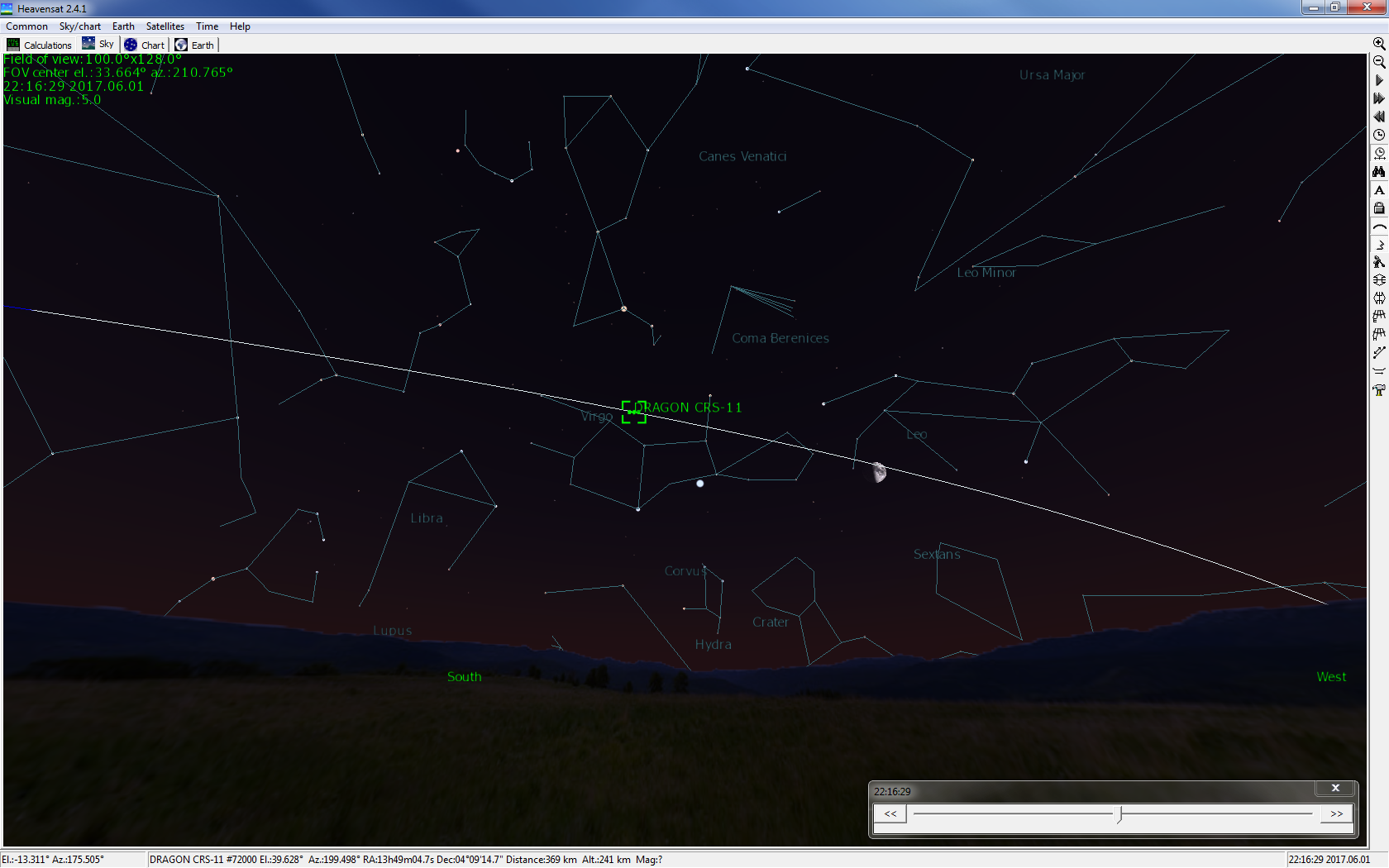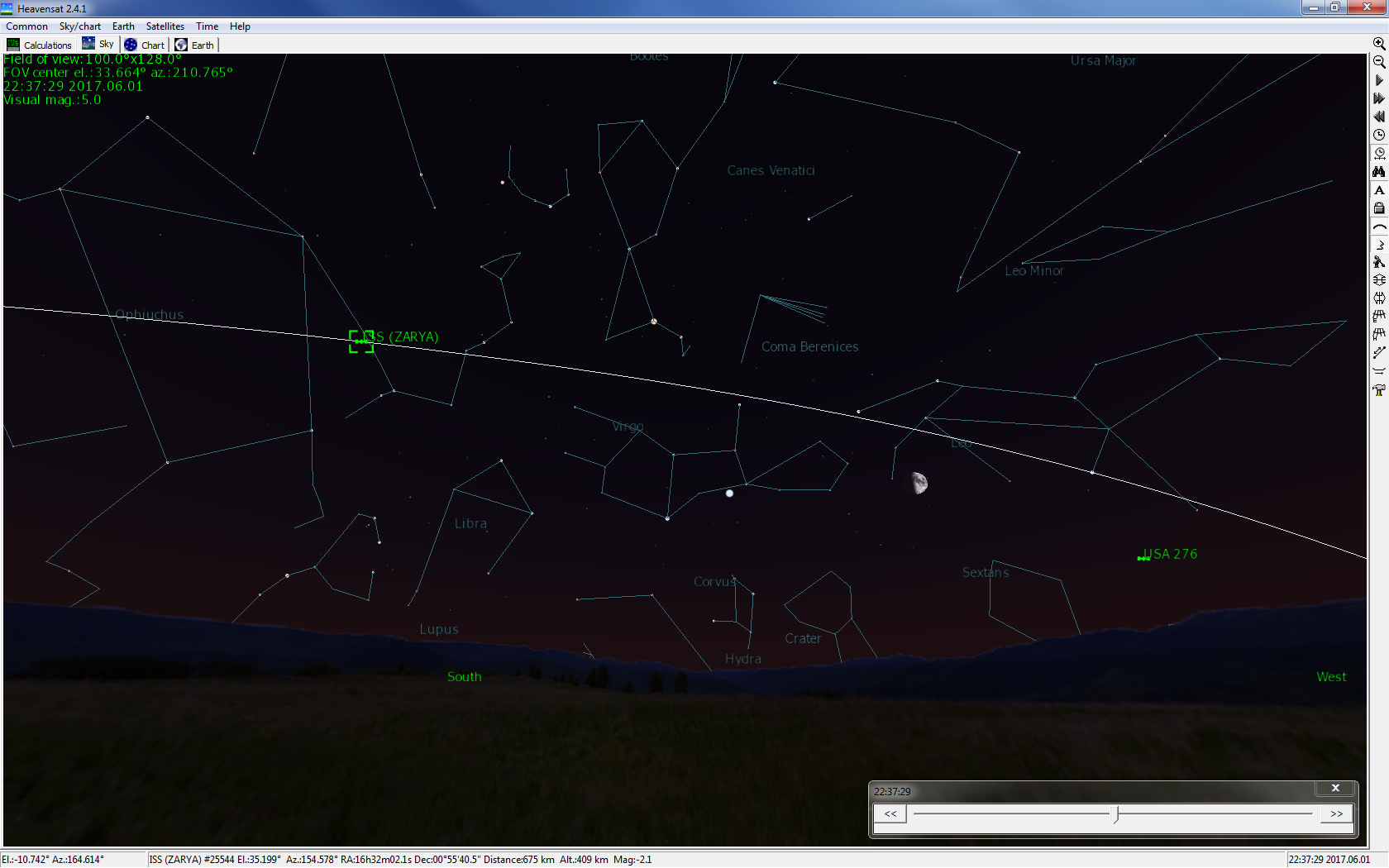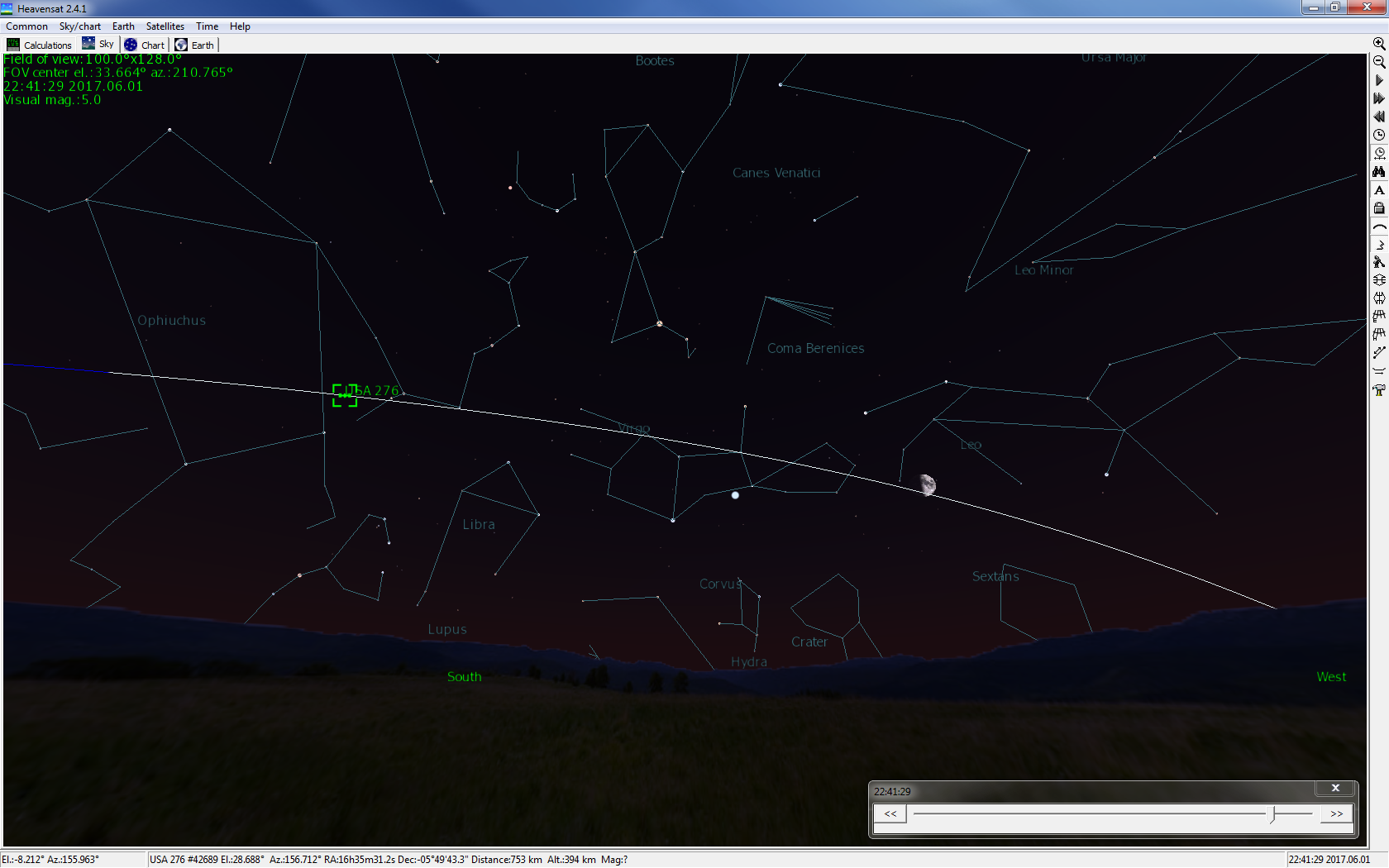› Forums › General Discussion › Satellite Pairings / Triplets in Low Earth Orbit
- This topic has 7 replies, 4 voices, and was last updated 8 years, 7 months ago by
 Nick James.
Nick James.
-
AuthorPosts
-
31 May 2017 at 1:54 pm #573764
 William StewartParticipant
William StewartParticipantDear All,
Some interesting satellite observing opportunities coming up soon that you may wish to keep an eye out for.
ISS Resupply mission CRS-11 is scheduled to launch on 01st June 2017 at 21:55 (all times GMT). Keep an eye on Spaceflight Now for details and (hopefully) live launch coverage.
The CRS-11 payload and the second-stage booster should be visible from the British Isles approximately 20 minutes after launch, passing just below Arcturus at 22:16:29. They will appear as two dots flying in formation. Keep an eye on both to see if there are any changes in brightness – the jettisoned booster could be tumbling and hence may show variation. If the CRS-11 launch is delayed by a few minutes, so too will the observing window over the British Isles. The booster is unlikely to stay up for long and hence this may be the only opportunity to see it.
The attached plot CRS-11 20170601_221629 shows the view from Cheshire with the objects rising in the west, passing due south and setting in the east. The further south you are, the higher in the sky the track will be; conversely the further north you are, the lower in the sky the track will appear. More westerly observers will see it rise and culminate a few minutes early; conversely the timings will be a few minutes later for more easterly observers. Suggest watching the launch live on the web (10 minutes) then getting out early and keep an eye on your south-west horizon!
On the plots, the white track is when the object is in direct sunlight while the blue portion shows when it enters the earth’s shadow after which it will slowly disappear from view (satellites don’t suddenly disappear from view – some light is refracted through the earth’s atmosphere).
While not as spectacular as back when the shuttle used to launch to the ISS and the Orbiter and jettisoned External Tank could be seen together (see example here) this will certainly be interesting to see.
The ISS will follow a similar trajectory a further 20 minutes later (see ISS 20170601_223729) while 4 minutes later a recently launched (01st May 2017 – see details here) classified US payload (NROL-76 / USA-276) will pass by (see USA-276 20170601_224129).
What is especially interesting is that the ISS, CRS-11 and USA-276 are in similar orbital planes and hence will follow similar paths across the sky. The latter two are in lower orbits than the ISS and hence in the coming days will “catch up” with it as they circle the earth on the “inside track”. For CRS-11 this is a typical rendezvous manoeuvre. It’s orbital period is approximately 3 minutes shorter than that of the ISS and so after about 30 orbits (under two days) it will have caught up with the ISS and will at the right moment boost itself up to the ISS for docking. Once launched, the plots for CRS-11 and the ISS should be readily available on Heavens-Above – make sure you set your location in order to obtain correct timings. The plot for USA-276 (being a classified payload), will not.
What’s unclear is what USA-276 is up to. Assuming its orbit does not change in the interim it will be quite close to the ISS around the time that CRS-11 will be on final approach. There is some speculation on the web (see here) but the short answer is that we don’t have any good answers. Either way, seeing the ISS, CRS-11 and USA-276 flying together will be an interesting sight on the 02nd and again on the 03rd June (when the formation will be even tighter). And we’ll have two observing passes per night! Again, keep an eye on Heavens-Above for details of passes of the ISS and CRS-11. The mystery third satellite will not be on the charts but will be USA-276.
As an added couple of bonuses, if you are in the right location (northern England), one or more of the objects may occult the moon. In addition we know that the radio meteor observers often detect the ISS (see here) … will be interesting to ascertain if they also detect the other two satellites as all three pass through the radio beam from GRAVES.
Finally, all times noted are GMT; add 1 hour to convert to BST.
Credit to the team over as SeeSat-L (see postings of 24th May 2017) for highlighting this opportunity. Plots generated using HeavenSat.
All we need now are clear skies …
Best regards, William
1 June 2017 at 10:35 pm #578263 Nick JamesParticipant
Nick JamesParticipantThe CRS-11 launch has been scrubbed due to bad weather at the Cape. Next opportunity is Saturday.
2 June 2017 at 8:49 am #578264 William StewartParticipant
William StewartParticipantAs noted by Nick, last night’s launch was scrubbed (due to lightening in the area – one of the lessons learned from the Apollo 12 launch). There’s some time sensitive items in the payload that need to be swapped out and hence the next launch attempt will be Saturday 03rd June at 21:07 GMT. As before, the CRS-11 module and secondary booster should be visible from the British Isles approximately 20 minutes after launch. While the forecast for weather in this part of the world is better than what we had last night, the moon phase will have increased and hence is more likely to hinder observations. Updated plots (based on Marco Langbroek’s updated elset) attached – all times (see time-slider at the bottom of the plots) are GMT so you’ll need to add an hour to convert to BST.
For those who are interested, there’s some informed speculation from Ted Molczan as to what role USA-276 / NROL-76 may play in all this.
Best regards
William
3 June 2017 at 10:55 pm #578269 William StewartParticipant
William StewartParticipantCRS-11 capsule and second stage booster easily seen from Cheshire 22 minutes after launch as two bright points of light flying in very close formation with two fainter points (jettisoned solar panel covers) either side.
Hope everyone else managed to see them too!
4 June 2017 at 9:30 am #578270 DawsonParticipant
DawsonParticipantFascinating.
James
4 June 2017 at 10:47 pm #578276 Richard SargentParticipant
Richard SargentParticipantI saw it too William. I watched the launch live on NASA TV and then went outside with a pair of binoculars. There was some broken cloud but then it appeared just as you described. I was expecting 2 points of light so when the binos showed four points travelling together at some speed I initially wondered if I was watching the lights of an aircraft! Anyway it was quite special to watch the launch and then about 20 minutes later to see the vehicle and its second stage pass through my evening sky. Thanks very much for posting the details in advance.
5 June 2017 at 7:41 am #578277 William StewartParticipant
William StewartParticipantHi Richard – good to hear you saw it too.
For those of you who missed it there’s a video on Youtube (not taken by me I hasten to add but by “Melgigg”). Note the puff from a thruster at around 1:10
The variation in brightness of the jettisoned solar panel covers (the two fainter dots either side of the main pair) as they tumble is obvious.
Best regards
William
5 June 2017 at 6:06 pm #578279 Nick JamesParticipant
Nick JamesParticipantThat Youtube video is fantastic, particularly the thruster plume. Unfortunately I was distracted by other things on Saturday night so forgot all about it. I clearly missed a very nice display.
-
AuthorPosts
- You must be logged in to reply to this topic.



